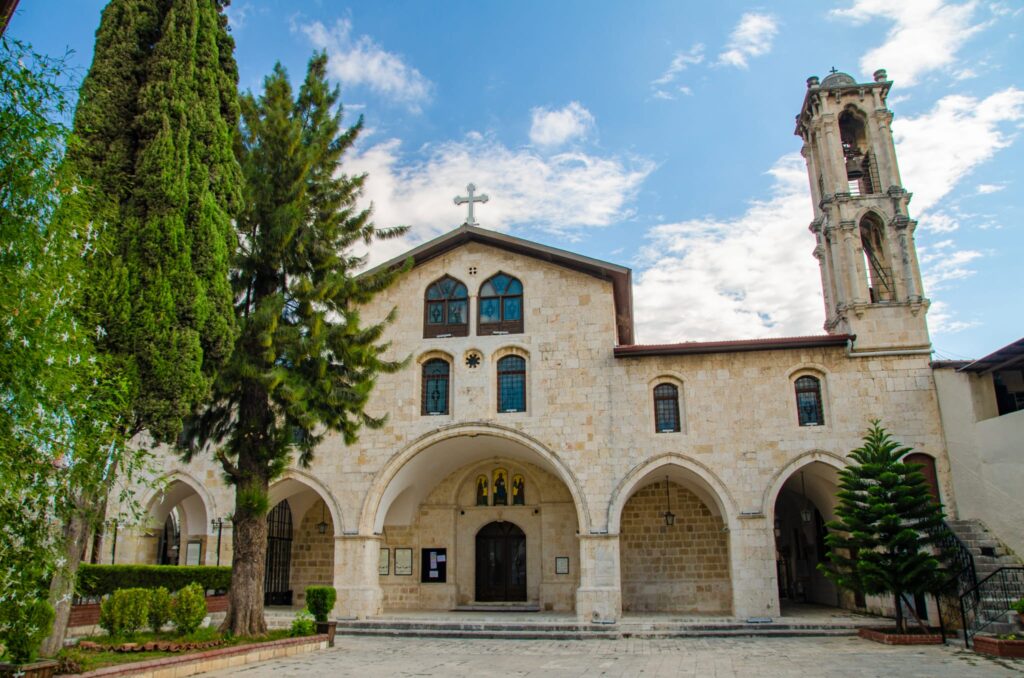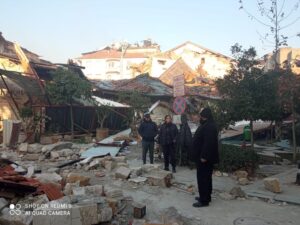Dr. Samuel Noble will be teaching a class on the history of Antioch beginning May 8th. For more details or to sign up, visit the link here. Below is a letter from Dr. Noble about the upcoming course.
Just to give a bit of background about myself, I’m a historian specializing in the history of Middle Eastern Christianity, in particular the history of the Patriarchate of Antioch in the medieval and early modern periods . . .
It’s difficult to cover over a thousand years in just four classes, but I hope those who join will come away with a clear picture of Antioch’s unique Orthodox Christian witness, and familiarity with the saints and leaders who shaped this story—some of whom, like St John of Damascus or the Patriarch Macarius III, might be well-known, and some, like St Timothy of Kakhushta or Abdallah ibn al-Fadl al-Antaki, might be met for the first time. I hope to see many of you there!
In Christ, Samuel Noble
Enter code OH25 to receive 25% off on Dr. Noble’s Course.

The Cathedral of Saints Peter and Paul in Antakya prior to the earthquake. The cathedral was built in 1833 and reconstructed after an earthquake destroyed it on Holy Friday in 1872.
In the early hours of Monday morning, February 6, a devastating earthquake struck southern Turkey and Syria, leveling buildings and killing thousands. Among the cities most affected was Antakya, Turkey – that is, Antioch. At the time of Christ, Antioch was one of the three great cities in the Roman Empire, along with Alexandria and Rome itself. It was an early headquarters for the Apostles, and it was, famously, the place where the followers of Christ were first called “Christians.”
As the “pentarchy” of preeminent churches emerged in the centuries that followed, Antioch’s place among the chief centers of global Christianity was secure. Its prerogatives were confirmed by Ecumenical Councils, and in the time of the Emperor Justinian, the bishop of Antioch was formally given the title “Patriarch,” along with the bishops of the other sees of the Pentarchy.
In the seventh century, the Arab Muslims conquered Syria, and in time Arabic became the dominant language of both the city of Antioch and of the Patriarchate, supplanting Syriac and Greek. This was true to a surprising degree even when the Byzantines reconquered the city in 969: Antioch and its surrounding monasteries, particularly the Monastery of Saint Symeon Stylites the Younger near modern-day Samandağ (whose name comes from the Turkish for “Symeon’s Mountain”) were extremely important centers of Arab Orthodox theological culture and translation. (For more on that, click here and here.)
The city and its region violently changed hands numerous times: after the Byzantines, it was taken by the Seljuk Turks in 1084, then captured by the Crusaders. Finally, in 1268, the city and its many neighboring monasteries were destroyed by the Mamluk hordes, which slaughtered or enslaved virtually everyone. Periodic earthquakes have also left a lasting mark on the city: one in 1092 was so catastrophic that it is commemorated on February 28 in Arabic manuscripts of Antioch’s Synaxarion that were copied and used at least into the early Ottoman period.
In the mid-14th century, the seat of the Patriarchate of Antioch permanently moved to Damascus, merging the two sees of Antioch and Damascus. Recovery for the Orthodox of Syria, including the region of Antioch, picked up steam after 1516, when the Ottomans conquered Syria and ended Mamluk rule. Antioch never recovered its status as a leading metropolis – it would always be overshadowed by the neighboring cities of Alexandretta (Iskenderun) and Aleppo – but it did reemerge as an important regional hub.
Under the Ottomans, Antioch was part of a district known as the “Sanjak of Alexandretta,” which was a subdivision of the Vilayet of Aleppo. After World War I, the Great Powers broke up the Ottoman Empire and France was given a mandate over Syria, including the Sanjak of Alexandretta. After 1925, this region was part of the new, French-controlled, State of Syria. But with Syria agitating for independence from France, in 1937, France decided to split Alexandretta off from the rest of Syria in a somewhat ambiguous autonomous arrangement, still under its control.
With World War II looming, in 1937 and 1938, France and Turkey signed an agreement providing for joint responsibility for the defense of Alexandretta and Turkish troops moved in. In 1938, the “Hatay State” was declared, with the idea that it would be a joint protectorate of France and Turkey. In June 1939, a referendum was held and Hatay voted to become a part of Turkey. In response, many Christians, Alawites and others decided to move across the border into Syria.
To this day, the modern Republic of Syria does not recognize the validity of anything France did there in the 1920s and ‘30s, and considers Hatay (which it refers to as the “Liwa’ of Iskenderun”) to be legally part of its own territory. Maps produced in Syria continue to reflect this.
Today, the population of the Hatay Province – the historic region of Antioch – is mixed Turkish- and Arabic-speaking, with mass education driving linguistic drift to Turkish among the younger generations. The province is majority Sunni Muslim, but it still has a very significant Arabic-speaking Alawite population and a small but visible Christian community that is predominantly Antiochian Orthodox, but with some Latins, Melkite Catholics, Protestants, and Armenians. Moreover, since the beginning of the civil war in Syria, a large number of Syrians have found refuge in Hatay.
Parishes currently exist (though their future is now in dire danger as reported) in Antakya, Iskenderun, Arsuz, Altınözü, and Samandağ. In addition, there is a single Antiochian Orthodox parish in the city of Mersin, located in ancient Cilicia, which since ancient times has been within the canonical territory of the Patriarchate of Antioch. Unlike Hatay, Mersin was within the borders of Turkey at the time the country was established following World War I. At the time of the population exchange / expulsion of Greek Orthodox Christians from Turkey to Greece, and Muslims from Greece to Turkey, in 1923, there was a dispute about whether the Orthodox of Mersin, who spoke both Arabic and Greek, would be included in the exchange. After much back-and-forth (which at one point involved consulting the Encyclopedia Brittanica), it was agreed that as Arabs under the Patriarchate of Antioch, they were not “Rum” in the sense intended by the treaty between Greece and Turkey. (For more on that story, click here – machine translation works pretty well on this article.)
The more uniformly Greek-speaking Orthodox of Tarsus and Adana, however – who were also under the Patriarchate of Antioch – were expelled to Greece.
Today, the parishes of Hatay and Mersin are under the Metropolitan of Aleppo, based in Syria. In modern times, there were Antiochian metropolitans in Adana (up to about 1899) and Tarsus (up to World War I).
Because the Orthodox Christians of Hatay are not given a consistent ethnic label by the Turkish government, with some registered as “Rum” and some as Turks (and the people variously think of themselves as “Greek/Rum,” Turkish, or Arab), and the obvious sensitivities related to being a small ethno-religious minority, statistics are difficult to come by. A plausible number for Orthodox Christians in the Hatay Province at the time of the recent earthquake is around 7,000, with another 13,000 in the diaspora, both in Istanbul (where they make up a very significant proportion of the city’s “Rum”) and in Europe, especially in Germany. (Source)
You can help the suffering and help rebuild the ancient Orthodox community that came from and still lives in Antioch (Antakya), the surrounding region, and the devastated cities on the Syrian side of the modern border, by donating the the fund established by the Antiochian Archdiocese of North America.

Thank you for this.